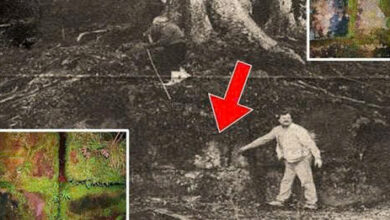Archaeologists Uncover Jesus’ Secret Words to Peter… Buried for 1,500 Years!
Archaeologists have uncovered a Byzantine church complex covering approximately 1,500 square meters beneath centuries of mud and sediment. Within this site, they discovered an ancient Greek inscription that could potentially reshape many long-held theological views in Christianity.
This extraordinary finding did not occur in Rome or any major academic center, but in Galilee — the very region where the biblical narrative begins. The 1,500-year-old Byzantine church was found near the Sea of Galilee, most likely built on the hometown of the apostles Peter, Andrew, and Philip.
Inside the church, an exquisitely preserved mosaic bears a Greek inscription that identifies Peter not just as an apostle, but as the “leader of the apostles” and the “holder of the keys to the kingdom of heaven.” This discovery is not merely historical but represents a theological bombshell—an enduring sacred message etched in stone that could alter the long-standing debates about authority within the Church.
The site of this discovery is Bethsaida, a town mentioned several times in the New Testament and known as the home of Peter, Andrew, and Philip. According to John 1:44, Philip was from Bethsaida, which was also the birthplace of Andrew and Peter. Yet, despite its biblical prominence, the exact location of Bethsaida has remained a mystery.
Many theories about Bethsaida’s location have been proposed, but few have been supported by convincing archaeological evidence. The excavation led by Professor Mordechai Aviam and Dr. Steven Notley unearthed a Byzantine church on the northern shore of the Sea of Galilee, buried under approximately 1,400 years of sediment.
Within the church, a Greek mosaic inscription was found that references Peter not only as an apostle but explicitly as the “leader of the apostles” and “the holder of the keys to the kingdom of heaven.” This phrase closely mirrors Jesus’ words to Peter in Matthew 16:19.
Remarkably well preserved, the mosaic inscription appears almost brand new despite being 14 centuries old. This extraordinary preservation suggests that it was meant to be discovered by future generations, perhaps a deliberate message preserved through time. Renowned scholars like Dr. Craig Evans regard this as the clearest archaeological evidence connecting Peter to his homeland. Dr. Notley emphasizes that this inscription is more than just decorative; it is a profound testament linking the church, the town, and the historical figure of Peter.
Bethsaida was historically a bustling fishing village—the name itself means “house of the fisherman” in Aramaic—perfectly fitting the known professions of the apostles who lived there. The New Testament records several miracles taking place in or near Bethsaida, including the healing of the blind man, the feeding of the five thousand with loaves and fishes, and Jesus walking on water nearby. Yet, it was also one of the cities Jesus famously cursed (Luke 10:13), predicting its downfall.
Following this curse, Bethsaida gradually faded from New Testament records and slipped into historical obscurity. During the Middle Ages, pilgrims searched for its location based on tradition, but there was no consensus. In the late 19th century, some scholars suggested a hill about two kilometers inland from the lake as Bethsaida, but this site did not fit well with the idea of a fishing village.
After the Six-Day War in 1967, new access allowed for fresh archaeological surveys of the region. A promising site called El-Araj was identified—a low-lying area near the Sea of Galilee showing signs of long-term habitation. In 2000, Pope John Paul II visited the site and was presented with an ancient bronze key found there, symbolizing the power of Peter as described in Matthew 16.
The University of Nebraska team initiated formal excavations, uncovering remains from the Roman period and a Byzantine church complex that included baths and lodging for pilgrims. Among the findings were three Greek inscriptions within the church, one of which was nearly intact and explicitly referred to Peter as the “leader of the apostles” and “holder of the keys to the kingdom of heaven.”
The inscription reads: “This mosaic floor was laid by the enthusiasm of Constantine, servant of Christ, for the leader of the apostles, the holder of the keys to the kingdom of heaven. Holy Peter, pray for him and his descendants.” The language is theologically precise, not just honoring Peter as an apostle but affirming his primacy among them.
This inscription reflects the beliefs of early Byzantine Christians and aligns with historical accounts. It confirms the tradition that the church was dedicated to Peter and Andrew in Bethsaida. A 725 AD record by Willibald, a Bavarian bishop, described staying at a church in Bethsaida dedicated to Peter and Andrew—previously thought to be legendary, this record gains credibility with the archaeological evidence.
The church not only preserves names and prayers but also a living memory and faith—an uncommon link between textual tradition and archaeological reality. It stands as proof that Bethsaida was a real fishing village where Jesus’ apostles lived, and that the church was deliberately built on this sacred ground.
Much like other important Christian sites—the Church of the Nativity in Bethlehem, the Church of the Holy Sepulchre in Jerusalem, and the Church of the Annunciation in Nazareth—this Byzantine church in El-Araj stands on a historically and religiously significant location, demonstrating continuity of faith and tradition.
The inscription confirms Peter as the “leader of the apostles” with authority and as the “holder of the keys to the kingdom of heaven,” echoing the foundational verse of Matthew 16:19. The mosaic was created in Greek rather than Latin, indicating that the belief in Peter’s authority was recognized in both Eastern and Western Christian traditions well before the Great Schism.
In conclusion, this discovery not only confirms Bethsaida as the true hometown of Peter, Andrew, and Philip but also provides vital archaeological evidence regarding Peter’s leadership role in the early Church. It challenges previous assumptions and clarifies long-standing theological debates about apostolic authority.




